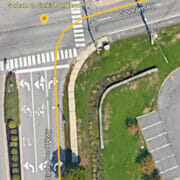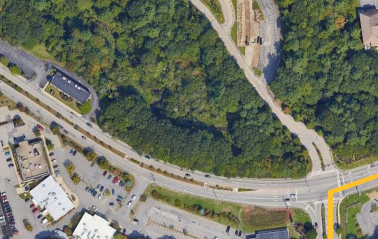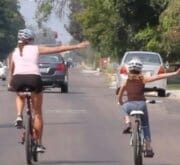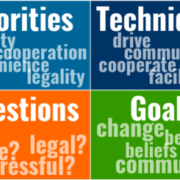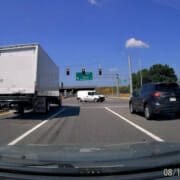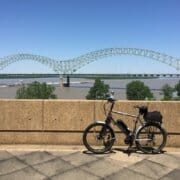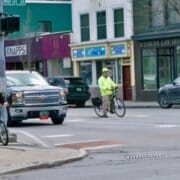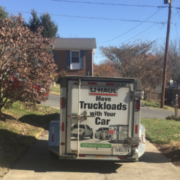The Quarter Mile Stroad Hack
In my initial “Stroad Hack” article, I described a hack involving two intersections. I referred briefly to the quarter mile on a different stroad, but I didn’t go into detail on that.
This post will focus on the quarter mile, on Gorham Road. It stretches from left to right in the image below. I use it quite often to go to my dentist’s office.
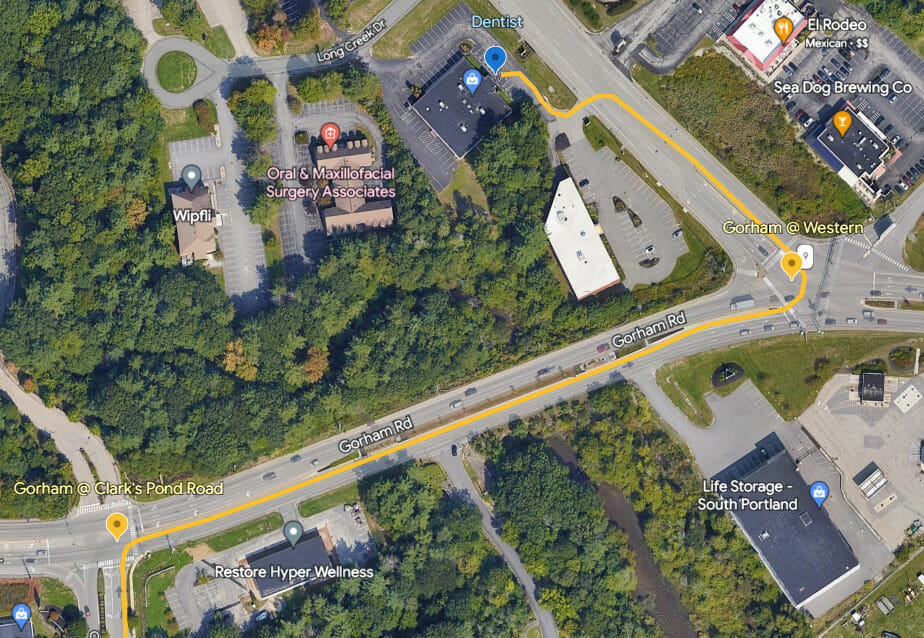
Use Online Maps…and Work Backwards!
Route planning has of course always used maps, initially on paper. I rely heavily on online maps in these articles, and particularly on Google’s ground-level Street View. Zooming in on Google’s satellite view lets you plan your lane choice. That is especially useful on multi-lane roads that you may be apprehensive about.
Always Use Maps?
So, is it necessary to plan every stroad route with mapping? No, I don’t think so. One of my favorite ways of riding is to explore a new area when I go on vacation. Serendipity is an important aspect of those rides for me. “Hey, that road looks interesting, let’s see what’s down there.” Cycling by the rules of the road is generally safe, even on an unfamiliar road. But you may want to choose mapping, especially when you know you will be on uncomfortable roads. It can allow you to make more informed decisions so the journey is more comfortable.
Mapping is also useful for illustration in these articles. I am using Google Earth for these images, although Google Maps works too. Custom maps are a great teaching tool!
Why work backwards?
When planning a route, it is often useful to start from the destination and work backwards. That way, you’ll see what works as you approach it — and at each step as you work backwards to the start. For that reason, I am numbering the following hacks in reverse order, going back from from the turn into the dentist’s office, to the quarter-mile segment, to the start.
Hack 3 – Lane Choice onto Western Avenue
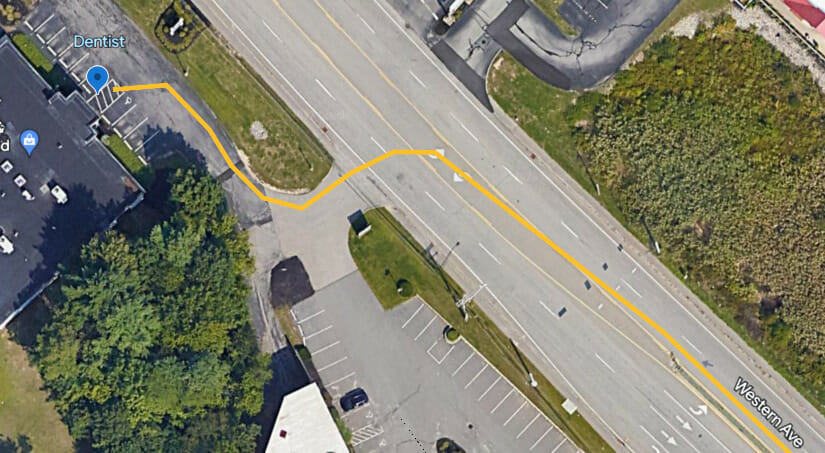
My dentist’s office is on the left side of Western Avenue. Conveniently, Western Avenue has a two-way center turn lane where I can wait for oncoming traffic to clear, before turning left into the driveway. If I’m already controlling the leftmost through lane, moving into the center turn lane as soon as it opens up is trivial.
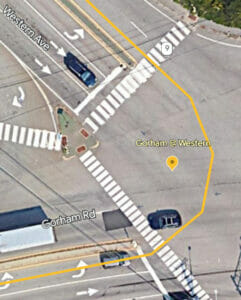
Following the rules of the road for drivers, you must use the left-turn lane to turn onto Western Avenue from Gorham Road. If you’re uncomfortable with that, you can dismount and use the crosswalks. But we won’t go into that here.
What lane on Western Avenue do you turn into? Bicyclists who feel like they must always stay to the right might be tempted to turn into the rightmost lane, because “bikes stay to the right”.
Then Why Turn into the Left Lane?
There are (at least) two reasons to choose the left lane. For one, it’s more common when turning onto a multi-lane road to turn into the closest lane, Maine laws do not actually require that, though some states do, and it makes sense here regardless.
There’s an important operational reason here too: It’s only about 225 feet from the intersection to the center turn lane. It’s only about 100 feet more to the driveway. That’s only 25 seconds at 10 MPH. It makes no sense to turn into the right lane, then immediately have to change to the left lane to get to the center turn lane. If you do that, any traffic behind you will turn into the left lane to pass you, and will block your lane change. Why not just turn immediately into the left lane? Any traffic behind you will pass you in the right lane, which is exactly what you want anyway!
So there’s one hack: Turn from Gorham Road into the left lane of Western Avenue.
Hack 2 – Lane Choice onto the Quarter Mile
Continuing backwards, what about the lane choice onto Gorham Road?
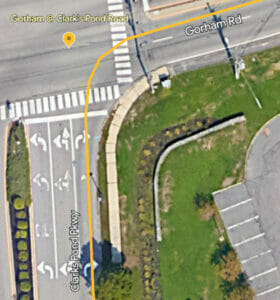
This decision is like the last one. You’re going to spend less than 1/4 mile on Gorham Road (just over a minute at 10 MPH) before you turn left onto Western. So why turn into the right lane and have to change immediately?
Objections?
Granted, that’s a bit longer time spent in a leftmost lane than on Western Avenue. And that might bring up another objection, that motorists don’t expect bicyclists to travel in the left lane for an “extended” time. In”motorist time,” that may be about 10 seconds. 😉 But in our experience, visibility to people approaching from behind more than makes up for any surprise they may have. They still have plenty of time to see you and react.
If you are in a left through lane because you will be turning left shortly, try making occasional left turn signals. I think people are more patient if they understand why you are doing what you are doing. It may also be that they respect you more if they feel like you know what you’re doing. (And as a Savvy Cyclist, you do!)
Evaluating Convenience
I sometimes would still have had time to change lanes if I turned into the right lane here. But I don’t know that when I make the turn. And, whichever lane I choose, motorists behind me in that lane will have to change lanes. So it comes down to a balance of convenience: how convenient is which lane for me, and how many motorists will have to change lanes? Results vary by location, by time of day, and by what the traffic happens to be at that moment. But in this place, I don’t try to overthink it, and simply choose the left lane. The next and final hack makes that even easier.
Hack 1 – When to Turn Right onto the Quarter Mile
Here’s one I never learned until I took CyclingSavvy, even after I had been become a certified instructor with another national cycling program. I’ll frame it as a question:
Q: When would you not want to take a right turn on red?
Everyone makes right turns on red, right? Why wouldn’t you? Bicyclists don’t like delay any more than motorists do. (Consider how many cyclists don’t bother stopping at lights if they think they can make it through. And how many pass even a short line of stopped cars on the way there.)
Red Lights Create Gaps
The answer never occurs to most motorists, including me before I started bike commuting. But you may have noticed it if you’ve cycled in traffic for very long: traffic travels in packs.
And why does this happen? In urban and suburban areas, it’s because of red lights. A red light collects a line of traffic while it’s red. Then it turns green and the whole pack surges forward.
The flip side to this is that red lights also create gaps. While that light is red, the only traffic entering the intersection is turning into it from the left or right (as we are in this case). This is nearly always much less traffic. Therefore, there are gaps for as long as the light is red. And effectively longer, because you’ll have traveled away from the intersection!
We have videos in our Truths & Techniques and CyclingSavvy Mastery courses showing gaps of more than a minute in length created by long light cycles, even at rush hour. You can also see it in this Smart Moves video about riding across a high-speed interchange.
Waiting for the Green when Turning Right…
So, a very basic hack that you can use at every signalized right turn is: Don’t turn right on red. Even if you are allowed to turn right on red, you may wish to wait. Waiting for your green guarantees that you will have a gap with very little or no traffic behind you (except the few that turn onto the road during that time).
Of course, if traffic is light, it may be fine to turn right on red once the initial pack is clear of the intersection. This is especially so if you have the sight distance to see that there is no more oncoming traffic for quite a while. That’s fine. This is a tool, not a hard and fast rule.
As I turn right from Clark’s Road onto the quarter mile segment on Gorham Road, though, the traffic from the left is coming around a curve, so it’s impossible to tell how long until more comes. And it will probably be traveling at the posted speed (or greater) by that time, maybe even racing a yellow. So I almost always wait for the green here.
Car behind you?
What if, you may ask, there is a motorist behind you who would like to turn right on red?
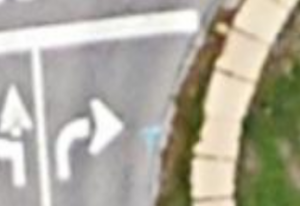
Well, you can simply move over and motion for them to go ahead. Whether you move depends on the geometry. In this case, the right turn lane gets wider, so I tend to stop at the extreme left side of it. That way, I leave room for a car to turn on my right. I’ll motion for the driver to do that if necessary.
Where the turn is more squared off, you may not be able to extend this courtesy. Moving to the right can put you in a position to be cut off by turning drivers when the light changes.
Summary
In this article, I showed a typical bike trip from my office to my dentist’s office around the corner. In that trip, I utilized two different CyclingSavvy stroad hacks. First, I chose to wait for a green light to make the right turn onto Gorham Road, to ensure that I could turn into a gap, and be well established on the road as I prepared to turn left onto Western Avenue. In many cases, I’m already pulling into the left turn lane before any traffic catches up to me!
Secondly, I turned directly into the left through lane, twice. In both cases, it was because it was a short distance to another left turn, so it was not worth starting in the right lane and then changing. Traffic turning behind me has a clear lane on my right to pass me in.
These two general purpose hacks are applicable on any stroad, in a great variety of situations. Having these tools in your toolbox will greatly ease the friction that you might otherwise experience on such car-centric roads. They are what makes you a Savvy Cyclist.

